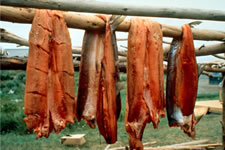Subsistence Food Safety – Assessing the Risks and Benefits
To read the current State of Alaska fish consumption guidelines, click
here.
 © Alaska Division of Tourism
© Alaska Division of Tourism The Environmental Public Health Program is engaged in an ongoing effort to characterize the safety of subsistence foods in Alaska. This process involves an assessment of the health benefits and risks of subsistence food consumption. Alaska fish and marine mammals are valuable sources of protein, vitamins, minerals, and other important nutritional components like heart-healthy omega-3 polyunsaturated fatty acids. Subsistence food use is also associated with important cultural and economic benefits.
The Environmental Public Health Program is carefully considering these known nutritional, cultural and economic benefits of subsistence foods, as well as the possible health risks associated with the consumption of contaminants in these foods.
 © John Hyde, Alaska Division of Tourism
© John Hyde, Alaska Division of Tourism The health risks posed by the consumption of contaminants in subsistence foods must also be balanced against the health risks of alternative replacements foods which are often less nutritious. Contaminants that have been detected in some subsistence foods include small amounts of cadmium and methyl mercury, and organic chemicals such as polychlorinated biphenyls (PCBs). These contaminants are also found in small amounts in some store-bought foods.
Comprehensive reviews of the levels of contaminants in Alaska subsistence foods, the risks associated with those levels, and the benefits of subsistence food use are available on the
State
of Alaska Library Archives website.
The risks and benefits of consuming subsistence foods must be taken into account when devising consumption guidelines.
Benefits
- Nutrition
- Taste
- Socio-cultural value
- Economic value
- Heart health
|

|
Risks
- Less healthy food substitutes
- Accidents – hunting/fishing
- Contaminants
- Parasites
|
Adapted from Dr. Harriet Kuhnlein, Centre for Indigenous Peoples Nutrition and Environment
Some drawbacks of reduced fish consumption which should be considered include:
 © Alaska Division of Community and Business Development
© Alaska Division of Community and Business Development - Health risks associated with alternative foods
- Increased consumption of saturated fat which can lead to cardiovascular disease
- Increased consumption of carbohydrates which can lead to obesity and diabetes
- Loss of nutritional and health benefits
- Overall negative health impact of dietary and lifestyle changes
- High cost of replacement foods
- Social, economic and health consequences from the breakdown of subsistence
The risks and benefits of subsistence foods in the scientific literature:
Mozaffarian, D., Rimm, Eric. Fish Intake, Contaminants, and Human Health: Evaluating the Risks and the Benefits. JAMA.2006 Oct 18; 296(15):1885-99. Review. Erratum in: JAMA. 2007 Feb 14; 297(6):590.
Willett, W., Fish: Balancing Health Risks and Benefits. American Journal of Preventive Medicine 2005; Nov 29(4):320-1
Hibbeln Jr., Davis JM., Steer C., et al. Maternal seafood consumption in pregnancy and neurodevelopmental outcomes in childhood (ALSPAC Study): an observational cohort study.
Lancet 2007; 369(9561):578-85.
Kuhnlein, H. Benefits and risks of traditional foods for Indigenous Peoples: focus on dietary intake of Arctic men.
Canadian J. Physiol. Pharmacol. 1995 Jun; 73:765-771
Websites & Documents of Interest:
To find out more about the subsistence foods safety program, contact the Environmental Public Health Program either by phone (907-269-8000) or e-mail (eph@alaska.gov).
